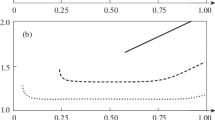Abstract
Material responses and fracture criteria relevant to the description of spallation phenomena are reviewed. The state of the material at the instant of fracture is an important part of a fracture criterion. The stress state associated with plane strain is described, and the effect of the initial conditions and the time dependent conditions of the material on spallation are discussed. The important quantities in any fracture criterion are the applied stress state, the size of the critically stressed region, the critical value of stress at which fracture begins, and the critical crack velocity. Stress gradient and cumulative damage spall-criteria are discussed in relation to these more fundamental quantities. Finally, some experiments are suggested that would isolate important parameters of the spallation process.
Résumé
On discute différents aspects du comportement d'un matériau et de sa rupture dans des conditions qui correspondent à la description type de l'écaillage. Une donnée importante pour établir un critére de rupture est l'état du matériau au moment de la rupture. On décrit l'état de contraintes correspondent á un état plan de déformation, et on discute l'influence qu'ont sur l'écaillage les caractéristiques initiales du matériau, ainsi que l'évolution de ces caractéristiques au cours du temps.
Dans tout critere de rupture, les facteurs dominants sont l'état de contraintes appliquées, la dimension de la zone critique sous contrainte, la valeur critique de la contrainte à laquelle la rupture se déclanche, et les vitesses critiques de fissuration.
On discute la manière dont les critères d'écaillage basés sur le gradient de contrainte et sur le dommage cumulatif, qui sont les plus containment utilisés, sont en relation avec ces notions plus fondamentales.
Enfin, on suggère certains essais qui pourraient être entrepris pour isoler certains facteurs importants qui jouent un rôle dans l'écaifage.
Zusammenfassung
Verschiedenen Gesichtspunkte des Verhaltens and des Brechens von Materialen, unter Bedingungen die der typischen Beschreibung des Abschuppens entsprechen, werden besprochen. Der Zustand des Materials in dem Augenblick wo der Bruch stattfindet, ist eine wichtige Angabe für das Aufstellen einer Kennwertes des Bruchverhaltens. Der Spannungszustand für eine plane Verformung wird beschrieben, und der Einfluß der Materialeigenschaften im Ausgangszustand sowie ihrer Veränderungen im Laufe der Zeit auf das Abschuppen werden erläutert.
Bei jeder Kennzeichnung der Bruchverhaltens treten als wichtigste Faktoren die folgender hervor: der angelegte Spannungszustand, die Abmessungen der kritischen Zone die sich in Spannungszustand befindet, die kritische Spannung welche den Bruch auslöst Bowie die kritische Rißbildungsgeschwindigkeit.
Die Zusammenhänge zwischen diesen mehr fundamentalen Größen and den gelaufigen Kennwerten zur Beurteilung des Abschuppens d.h. dem Spannungsgradienten and dem kumulativen schaden werden besprochen.
Zum Schluß wird eine Reihe von Versuchen vorgeschlagen welche es ermöglichen sollen gewisse wichtige Faktoren die beim Abschuppen eine bedeutende Rolle spielen, zu isolieren.
Similar content being viewed by others
References
W. C. Lyons and F. R. Tuler, Failure Mechanisms in Materials and Structures Subjected to Short-Time Loadings, Institute of Environmental Science, Proceedings of Annual Meeting, (1969) 78.
N. Cristescu, Dynamic Plasticity, Interscience Publishers, New York (1967), p. 403.
L. M. Barker, Fine Structure of Compressive and Release Wave Shapes in Aluminum Measured by the Velocity Interferometer Technique, Behavior of Dense Media Under High Dynamic Pressures, Symposium H.D.P., IUTAM, Gordon and Breach, New York (1968), p. 483.
C. M. Glass, G. L. Moss and S. K. Golaski, Effects of Explosive Loading on Single and Polycrystalline Aggregates, Response of Metals to High Velocity Deformation, edited by P. G. Shermon and V. F. Zackay, Interscience Publishers, New York, (1961), p. 115.
D. C. Drucker, A Continuum Approach to the Fracture of Metals, Fracture of Solids, edited by D. C. Drucker and J. J. Gilman, Interscience Publishers, New York, (1963), p. 3.
J. Buchanan and H. James, Measurement of High Density Stress Pulses, Brit. J. Appl. Phys., 10 (1959) 290.
G. Thomas and R. L. Nolder, The Substructure of Plastically Deformed Nickel, Acta Met., 12 (1964) 227.
M. F. Rose and T. L. Berger, Shock Deformation of Polycrystalline Aluminum, Phil. Mag., 17 (1968) 1121.
E. E. Banks, Metallographic Features of Explosively Produced Spall Fractures in a Low-Carbon Steel, J. Iron & Steel Inst., 188 (1968) 1022.
B. R. Breed, C. L. Mader and D. Venable, Technique for the Determination of Dynamic-Tensile-Strength Characteristics, J. Appl. Phys., 38 (1967) 3271.
R. S. Thurston and W. L. Mudd, Spallation Criteria for Numerical Computations, Los Alamos Scientific Lab., LA-4013, (1968).
R. G. McQueen and S. P. Marsh, J. Appl. Phys., 33 (1962) 654.
M. Born and R. Furth, Proc. Camb. Phil. Soc., 36 (1940) 454.
J. T. Norton Chairman, Report Subcomm. Theor. Prop. Matls., Materials Advisory Board, Nat. Acad. Sci., Wash. D.C., (1966).
A. Kelly, Strong Solids, Oxford Press, Chap. l, (1966).
J. J. Gilman, “Dynamic Criteria for Crack Nucleation and Growth”, Proc. 1st Internat. Conf. Frac., 2 (1966) 733, Sendai, Japan.
J. R. Low, Symposium on Relation of Properties to Microstructure, American Soc. for Metals, Cleveland, Ohio, (1953), p. 153.
J. J. Gilman, J. Appl. Phys., 27 (1956) 1262.
E. M. Dulaney and W. F. Brace, J. Appl. Phys., 31 (1960) 2233.
B. M. Butcher, L. M. Barker, D. E. Munson and C. D. Lundergan, Influence of Stress History on Time-Dependent Spall in Metals, AIAA Journal, 2 (1964) 977.
T. W. Barbee, Stanford Research Institute, Menlo Park, California, Private Communication.
F. R. Tuler and B. M. Butcher, A Criterion for the Time Dependence of Dynamic Fracture, The International Journal of Fracture Mechanics, 4 (1968) 431.
F. A. Field, A Simple Crack Extension Criterion for Time Dependent Spallation, The Aerospace Corp., San Bernardino, Calif., Manuscript submitted for publication.
H. Kolsky and D. Rader, Stress Waves and Fracture, Fracture, edited by Harold Liebowitz, Academic Press, New York (1968) p. 533.
Author information
Authors and Affiliations
Rights and permissions
About this article
Cite this article
Gilman, J.J., Tuler, F.R. Dynamic fracture by spallation in metals. Int J Fract 6, 169–182 (1970). https://doi.org/10.1007/BF00189824
Received:
Revised:
Issue Date:
DOI: https://doi.org/10.1007/BF00189824




